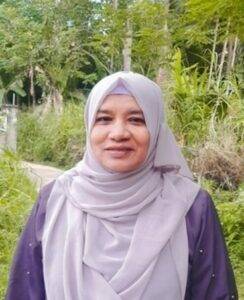Abstract
Collaborative Action Research method was employed to examine the author’s professional practice as a resource person and to take action to strengthen teaching and learning in a selected primary school in Sri Lanka. Qualitative data collected from In-depth interviews and videotaped observations were analyzed to develop a narrative story. Addressing the problem of teacher-centeredness in primary classrooms, an activity room was developed by the resource person/author using her experience and formal and informal training. Community support was used to develop the activity room, a new pattern for a school for Muslim children in Sri Lanka. Teachers were instructed to use the activity room for lessons. The teaching style of lessons in the activity room, however, initially was not different from traditional classroom lessons and teachers needed further orientation towards changing their role to organize child centered activities in the new setting.
Introduction
As a teacher and a resource person attached to the Department of Education of Central Province, Sri Lanka, I have been visiting Tamil and Sinhala medium schools to observe teaching and learning processes in the primary classrooms. Since 1999, from my observations, I have noted that diverse approaches do exist in teaching in both Sinhala and Tamil medium schools. Though expenditures on education are equally distributed among the schools and infrastructure development of schools in the province has advanced, no remarkable changes are evident in classroom teaching and learning approaches, classroom management, guidance and counseling for students, and motivation of students in Tamil medium schools with Muslim children. Overall, learning motivation and the acquisition of skills among the students have not developed adequately. Similarly, the application of scientific & technological innovations in the school settings are not at a satisfactory level.
Generally, teaching in observed clasrooms in Tamil medium schools with Muslim children is non-activity based. From Grade 1 onwards, teachers lecture the students. Teachers in other parts of the province show more variety in their use of teaching methods. Hence, the questions I sought to examine were “why do teaching methods differ in a country with one educational policy? What are the perceptions of teachers on their classroom practice? What remedial measures can be used to overcome this situation?” To obtain research-based answers, I selected a Tamil medium school with Muslim children to reconnoiter the existing situation and to conduct action research.
Setting
I have been visiting the selected Tamil medium school to provide guidance and advice as a resource person of the Department of Education, Central Province, Sri Lanka since 1998. There are 440 students studying under 30 teachers. There are 188 children in the primary classes (Table 1). Classes are conducted for Grades 1-13. There is no teacher shortage in the primary grades and all teachers are trained, with an average of more than 10 years of experience. Educational materials and related learning resources provided by the Ministry of Education are amply available in classrooms.
Table 1. Student population in primary grades
| Grade | No. of Childrem |
| 1 | 39 |
| 2 | 42 |
| 3A | 27 |
| 3B | 22 |
| 4 | 29 |
| 5 | 29 |
| Total | 188 |
Problem
Although sufficient human and physical resources are provided, I noticed a lack of innovation and student engagement in the teaching methods of teachers in the school (Vignette 1).
Vignette 1: Classroom practice
In Grade 3, the lesson ‘Number Pattern’ was taught by first introducing the pattern by the teacher and then asking children to repeat what was taught. This pattern of teaching and remote memorization within the classroom continues for ten minutes. Then follows the standing of children group wise and repeating the learned patterns. Then the teacher writes the notes on the ‘Patterns of Numbers’ on the blackboard to be taken down by the students. Then the teacher marks the exercise books. During the 30-minute lesson, although within the classroom premises there are resources that can be used for the specific lesson, no teaching aids other than the blackboard are used to enhance the conceptual development of the child.
Reconnaissance of the problem
In inquiring in depth about the prevailing method of teaching, using interviews with the teachers and the principal, it was revealed that in the past the In-service Advisors had not given specific guidance on teaching and even when they had given such guidance, the teachers were reluctant to adhere to it. They further said that the officers and advisers had always appreciated their work and no mistakes were pinpointed, and thus they did not feel the necessity for changes.
The teachers indicated that they tend to forget new knowledge acquired through in-service sessions and try to teach in the way they had been instructed previously. Although in the current teaching-learning environment teachers are expected to act as facilitators who respect children’s experience and abilities, in the observed classrooms in my project, the situation was different and indicated that a teacher-centered teaching learning process was dominant.
Reforms and changes under the new educational reform programme in Sri Lanka have in no way affected the classrooms in the selected school in a sufficient manner. Hence, the educational reforms remain as changes only in official documents in written words in this specific school. No constructive change could be seen in the achievements of the children as expected from the reforms.
Overall, the teachers in the selected school were like officers just directing others, without collaboratively working with children. They did not use teaching aids provided to them. They did not prepare themselves using experience gained through in-service training and teacher guides provided by the National Institute of Education (www.nie.ac.lk). The teachers said that the reforms were difficult for them. They reported that although they wanted to implement the reform initiatives, they faced the following difficulties:
- Lack of resources
- Difficulties and ignorance of making aids and insufficient time to use them in classrooms
- Inability in applying workshop experience organized by the In-service Advisors in classrooms
- Unavailability of safe cupboards to keep teaching aids and creative works of children.
- Lack of cooperation of the principal
- Lack of cooperation of the parents
Overall, the observed situation was a hindrance for the effective implementation of educational reforms initiated in 1998 with the aim of bringing down the rates of slow learners by bringing out their latent talents. Reflecting on the results of my observations and discussions with teachers I decided to intervene in the classroom teaching process and sought to develop an Activity Room that could be used to overcome the difficulties identified by teachers.
Plan of action and focusing on intervention
After identifying the existing situation, I explained the shortcomings of the present approach to teaching and learning through friendly discussions with the teachers. I conducted model classes that were observed by teachers. Apart from these measures, I wanted to change the teaching methods of the teachers who didn’t want to change themselves due to various reasons. As a resource person, to overcome the identified shortcomings I decided to develop an activity-based teaching-learning environment in which students would engage in learning with pleasure. I worked out a plan of action and gained the approval of the Zonal Director of Education.
Though I had planned these activities to be implemented in all Tamil medium schools with Muslim children in an educational zone, I could not implement them all due to a lack of cooperation by some of the schools, teacher/ principal transfers and administrative problems. I emphasized, however, the concept of Activity Room as an intervention to develop a sense of commitment among teachers to their teaching practices and also to gain fresh ideas on the concept as a resource person.
For the research, a plan of action, with the following steps, was developed and implemented as follows.
- Selection of one school: Obtaining the consent of the principal; Study the background of the school to find out facts about a suitable space to implement the activity room; Evaluation of the prevailing situation of the selected room.
- Preliminary discussion with school principal and teachers: Describing the importance of innovative practices at the classroom level to improve the classroom practice of teachers.
- Decide on the physical features of the Activity Room: Improving the indoor and outdoor classroom environment to facilitate activity-based learning; Designing learning activities to be implemented inside and outside the classroom environment / activity room.
- Intervene to develop the classroom: Creating a new unit of learning in the classroom, including preparing a proper & attractive classroom as well as setting up the subjects/students in groups and creating opportunities for the students to present their views.
- Institutionalization of the Activity room: The main objective to this project was to create a lively activity room and to train teachers on the use of the activity room. In addition, workshops for teachers, parents and students would be provided on “How can teachers and parents help students in learning?”. My intent was to lay a foundation for the institutionalization of the Activity room.
- Describing the importance of innovative practices at classroom level to improve classroom practice of teachers: As a part of introducing the change I explained to the teachers and principal the changes that can be attained by initiating activity-based teaching, including:
-
- Clean classrooms
- Innovative way of beginning lessons
- Introducing the lesson through demonstrations
- Guide children to motivate them
- Teaching method that is suitable to enhance child’s knowledge and ability
- Appreciation and exhibition of children’s creative work
- Diversified activities among groups
- Pre-prepared explanations by teachers
- Children’s independent presentations based on their learning.
- Evaluation of the prevailing situation of the selected classroom in preparation for taking action to change the learning environment: Prior to the project’s start, discarded furniture and books were piled up in a room between two primary classrooms. Broken furniture parts, poles etc. were piled up even outside that room. I found myself wondering how little children could learn happily in such an environment. I requested the principal to change this environment to a learning friendly one and allow me to pursue my aim. I requested that the identified room be used as a resource room for the primary section. Initially, the principal was reluctant to support the project as there was no other room to accommodate the junk stored in the proposed room. Nevertheless, with my frequent visits, guiding and persuasions, the teacher in-charge of the school’s primary section agreed to my request. Later I collected all the teaching aids used in primary classes and exhibited them in the cleaned room. When the teachers gazed at the newly organized space, they seemed amazed to identify such a huge amount of teaching aids from their classrooms, which had not been being used (see Figure 1). They seemed to be coming to a realization that they had not utilized available resources for classroom teaching. The teachers said that they had never seen or used these resources and that it would be convenient for them to use them when these resources were categorized and exhibited. But they also expressed concern about the safety of equipment. When I suggested to them that we could make the room in a safe manner, they said they could not meet the expenses themselves and could not ask the children to contribute funds either. Nevertheless, we continued to move forward.
Figure 1. Teaching aids in the new room
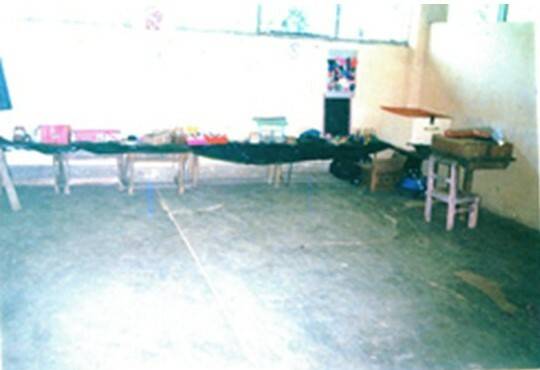
- Harnessing community support: A meeting was held for the parents of primary students in February 2005. The hall was filled with Muslim parents. Teachers told me that parents who had never come to the school before were present on that day. I explained to them the situation in Muslim schools and the achievements of Muslim students compared with non-Muslim schools and International Schools. I also explained to them the expenses they incur on behalf of their children by way of tuition, and that they could save money if they developed the Activity Room. I emphasized that schools, which are a common property of all, should be protected and developed. Provided an explanation, the parents in attendance concluded that they should extend their support to their children in learning. I also explained to them a variety of activities, games, etc. which are a part of primary education but which the parents indicated had never been explained to them and which they questioned had ever been used with the students in the school. Parents also were made aware of the essential components of teaching based on activities and inter group awareness introduced by the Ministry of Education. Since government aid may reach the school later than expected I requested that the parents help in building an activity room, which would definitely change their children’s education. Parents questioned me: “What is an activity room? Why should an activity room be set up? What benefits do we gain through activity-based learning?” I explained that the talents of children can be developed through this Activity Room and that we can help prepare a society with members who will be able to make decisions independently and constructively. Finally, the parents agreed to assist with constructing an activity room. A parent asked me what help I would be able to offer them through the Ministry of Education. I told them that I could contribute to the students’ achievement of education levels and make the school the best in the Education Zone. Ultimately, the parents appointed a committee and decided to construct a new attractively appearing activity room within four months.
- Constructing a new room with innovation: With a contribution of Rs. 65000/= the parents themselves built the activity room and managed the project financially. The developing activity room (Figure 2) provided suggestions for a changing role for teachers. The developed classroom (Figure 3) provided tangible evidence to help motivate teachers to change their role from teacher-centered order-givers to student-centered facilitators of learning. The completed activity room consisted of cupboards that can be used to keep teaching aids and equipment in a systematic manner and chairs and tables that can be arranged in flexible way for activities. A bookshelf is also available. The floor is carpeted so that children can use the floor for activities. Another feature is the non-availability of a blackboard, teacher table and teacher chair. This feature is intended to strengthen the teacher’s presence as a part of the student group. The Director of Primary Education indicated appreciation of the availability of both a resource room and a working room in one space.
Figure 2. The developing Activity Room
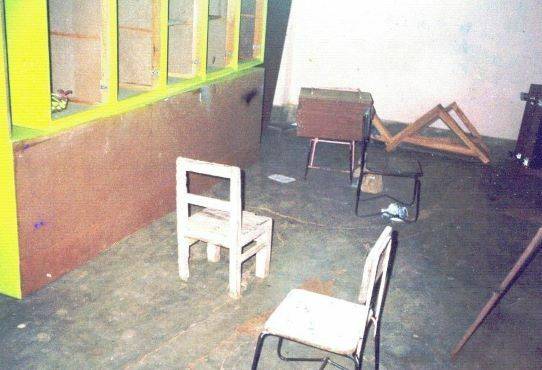
Figure 3. The developed Activity Room
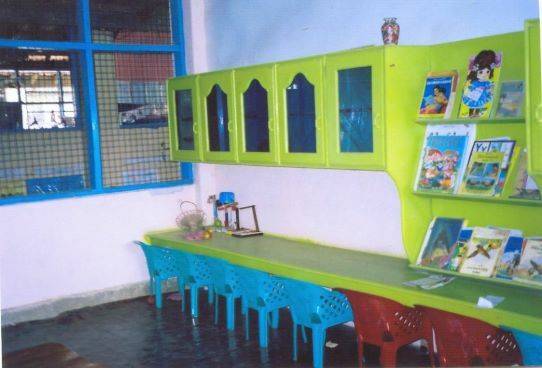
- Reflections of the practitioner on results: Over time, changes took place in the physical environment of primary classrooms in general and in the overall school environment (Figure 4). The Director of Primary Education became impressed by the accelerated transformation of the primary classes. He promised to provide additional resources to the school from the Ministry of Education. Due to the physical change taking place in this school it has been selected as a child friendly school at the provincial level and the Ministry of Education is currently assisting the school under a six-year project.
Figure 4. A renovated primary classroom
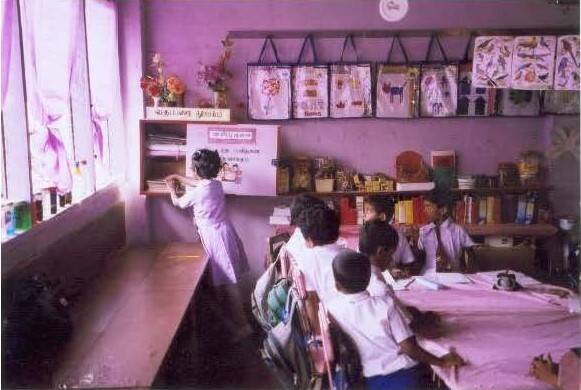
Even though classrooms were developed physically in an attractive pattern, no changes took place in the teaching methods. Teachers were reluctant to make changes in their classroom practice. Even if I conducted model classes on my visits to the school and offered instructions on the way of conducting child-centered lessons, teachers adhered to teacher-centered classroom practices. Even in the developed activity room, when they conducted classes, they tried to teach or lecture the students as in the normal classrooms (Vignette 2).
Vignette 2: A lesson in the activity room
This is a grade 5 environment lesson on “plants”. Teacher introduces the lesson showing pictures of plants and real seeds and leaves packeted and pasted on a Bristol board. They are sent round for pupils to observe. At the end, teacher shows a Bristol board display of plants in groups. The teacher then instructed the pupils to categorize plants in the form of a table in their books. This categorization turned out to be identical with the teacher grouping on the bristol board display. Though pupils were grouped, there was no group activity and though there were sufficient relevant resources in the activity room they were never used. Pupils were not given an opportunely to ask questions or to handle and feel the real seeds and leaves.
My expectation had been that the teachers would guide the children with activities that students can perform on their own, independently. They should find, search and reach their learning goals independently working within the Activity Room. But it did not bear fruit yet. The innovative lesson that gives freedom to the child (Figure 5A and Figure 5B) was perceived as a lesson that limits the role of teachers (Vignette 3).
Figure 5A and Figure 5B. Nature of innovative child-centered classroom
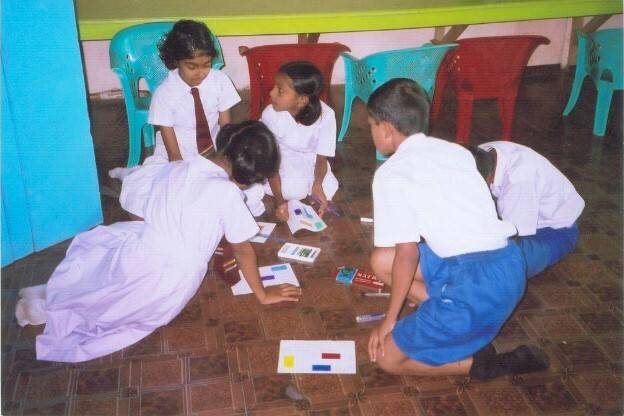
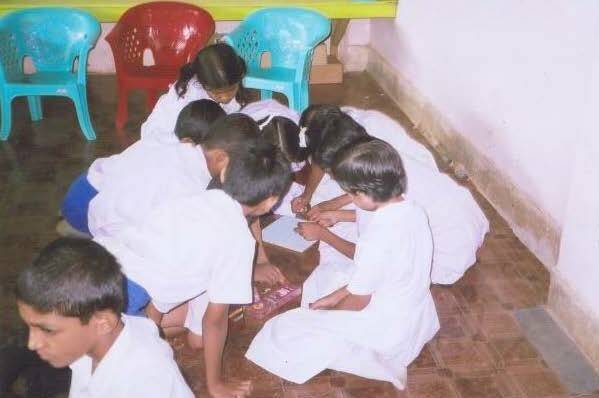
Vignette 3: Perception of teachers on the model lessons
Teachers who observed my model lessons in the activity room said that students move here and there in the room without any control and that teacher did nothing to control them. A classroom, to be good, should be under the control of the teacher. If the children behave independently without being controlled by the teacher, it can be considered as the weakness of the teacher. They also told me that if teacher teaches only, students could get knowledge. If teacher gives an explanation only students can answer questions. Further, teacher should always mediate in the activities of the child. An outside observer may think that the teacher is just idling in the class without teaching or controlling children.
Hence the problem I continue to face now is how to guide teachers to conduct child-centered lessons in the Activity Room. Although I have been successful in building an Activity Room in place of a traditional classroom, I now face the more difficult problem of converting the mindsets of teachers from teacher-centered practice to child-centered practice. If I am successful in this larger goal, the new Activity Room will be a space with active children learning by doing.
Overall reflections
The importance of action research in professional practice is often cited in research literature (Carr & Kemmis, 1986; Elliot, 1991; McNiff, 1993; Kemmis & McTaggart, 1999). However, “Action research is not [the] usual thing teachers do when they think about their teaching. It is more systematic and collaborative in collecting evidence on which to base rigorous group reflection” (Kemmis & McTaggart, 1999).
Although the characteristics of ‘collaboration’ (Lewin, 1946) and ‘reflection’ (McNiff, 1993) are built into my practice as an in-service advisor, my practice had previously lacked data-based judgments that could be used in my own professional development. Lack of data in the form of objective observations and subjective reflections led me to interview other in-service advisors to collect evidence about my own practice by comparing my practice with that of other in-service advisors. Further, to triangulate my views the photos I have collected were analyzed based on interviews with class teachers, the school principal, a member of the community and the Director of Primary Education. Further observations through video-tapes of two lessons in the activity room – one model lesson by me as an in-service advisor and another lesson by a teacher of the school – were used to collect data.
Suggestions
It was suggested that action research be adopted to enhance the capabilities of myself as the resource person. More practice with reflection and systematic collection of data will further enhance my capacity to serve the children in the zone.
References
Carr, W., & Kemmis, S. (1986). Becoming Critical: Education, Knowledge and Action Research. Geelong: Deaking University.
Elliot, J. (1991). Action Research for Educational Change. Milton Keynes: Open University Press.
Kemmis, S., & McTaggart, R. (1999). The Action Research Planner. Geelong: Deaking University.
Lewin, K. (1946). Action Research and Minority Problems. Journal of Social Issues, 2, 34-46.
Mcniff, J. (1993). Teaching as Learning: An Action Research Approach. London: Routledge.
To cite this work, please use the following reference:
Nihara, A. F. (2023, December 19). From classroom to activity room; from teacher to students. Social Publishers Foundation. https://www.socialpublishersfoundation.org/knowledge_base/from-classroom-to-activity-room-from-teacher-to-students/
